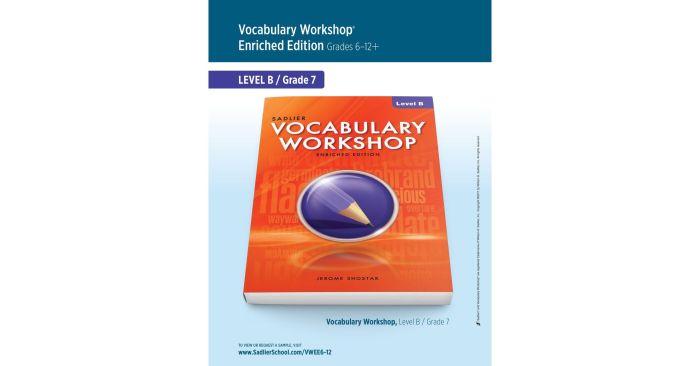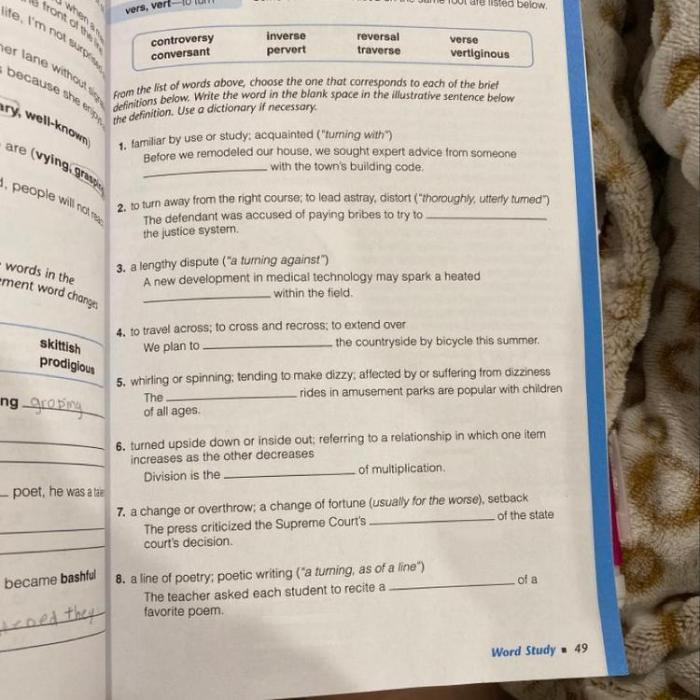Unlock the secrets to expanding your vocabulary with Vocab Book Level B Answers! This comprehensive guide provides a clear understanding of the book’s structure, key concepts, and effective strategies for building your word power.
Dive into the intricacies of word analysis, root words, and contextual vocabulary practice. Discover how Vocabulary Book Level B Answers empowers you to master new words and apply them confidently in real-world situations.
Vocabulary Book Level B Overview

Vocabulary Book Level B is designed for learners who have a basic understanding of English vocabulary and are looking to expand their word knowledge. It covers a wide range of topics, from everyday vocabulary to more specialized terms, and is suitable for students of all ages and backgrounds.
The book is divided into 10 units, each of which focuses on a different theme. The units are organized in a logical progression, starting with basic vocabulary and gradually introducing more complex words and phrases. Each unit contains a variety of exercises, including definitions, synonyms, antonyms, and fill-in-the-blank sentences, to help learners practice and reinforce their new vocabulary.
Content and Structure
The book’s content is divided into 10 units, each of which focuses on a different theme. The units are as follows:
- Unit 1: Basic Vocabulary
- Unit 2: Food and Drink
- Unit 3: Clothing and Accessories
- Unit 4: Home and Furniture
- Unit 5: Transportation
- Unit 6: Occupations
- Unit 7: Education
- Unit 8: Travel and Leisure
- Unit 9: Science and Technology
- Unit 10: Business and Finance
Each unit contains a variety of exercises, including definitions, synonyms, antonyms, and fill-in-the-blank sentences, to help learners practice and reinforce their new vocabulary.
Key Vocabulary Concepts
Vocabulary Book Level B introduces a wide range of vocabulary concepts to enhance students’ understanding and expression. These concepts are presented in a systematic and engaging manner to help students build a strong vocabulary foundation.
One of the key concepts is word families. Students learn how words are related to each other based on their root words and affixes. This helps them expand their vocabulary and understand the nuances of language.
Using Context Clues
Another important concept is using context clues. Students are taught various strategies to infer the meaning of unfamiliar words from the surrounding text. This develops their reading comprehension and critical thinking skills.
Synonyms and Antonyms
Vocabulary Book Level B also covers synonymsand antonyms. Students learn how to identify and use words with similar or opposite meanings. This enhances their ability to express themselves precisely and effectively.
Multiple Meanings
The book explores the concept of multiple meanings, where words can have different meanings depending on the context. Students learn to identify and use words appropriately based on their intended meaning.
Exercises and Activities
Throughout the book, students engage in various exercises and activities that reinforce vocabulary concepts. These include:
- Word sorts
- Context clue identification
- Synonym and antonym matching
- Sentence completion using vocabulary words
- Writing exercises that encourage vocabulary usage
By incorporating these key vocabulary concepts and engaging exercises, Vocabulary Book Level B provides a comprehensive and effective approach to vocabulary development.
Word Analysis and Root Words

Vocabulary Book Level B delves into the intricate world of word analysis and root words, providing students with the tools to decode and comprehend the structure and etymology of words. This component plays a pivotal role in expanding their vocabulary and fostering a deeper understanding of the English language.
Through engaging exercises and activities, students embark on a journey of discovery, unraveling the hidden meanings and origins of words. They learn to identify prefixes, suffixes, and root words, gaining insights into how these building blocks contribute to the formation and meaning of new words.
Etymology and Word Structure
Word analysis and root word study provide students with a solid foundation in etymology, the study of word origins. By tracing the historical evolution of words, they gain an appreciation for the diverse influences that have shaped the English language.
This knowledge empowers them to make connections between words, expanding their vocabulary and comprehension.
Exercises and Activities
Vocabulary Book Level B incorporates a wide range of exercises and activities that reinforce word analysis skills. Students engage in:
- Identifying prefixes, suffixes, and root words in unfamiliar words
- Analyzing the etymology of words to uncover their origins and historical development
li>Building new words by combining root words with prefixes and suffixes
Contextual Vocabulary Practice
Vocabulary Book Level B provides comprehensive exercises to help students master vocabulary in context. These exercises encourage students to apply their vocabulary knowledge beyond isolated word lists, fostering a deeper understanding and ability to use vocabulary effectively in real-world situations.
The exercises include:
Sentence Completion
Sentence completion exercises present students with incomplete sentences and ask them to choose the correct word from a given list to complete the sentence meaningfully. This activity helps students understand the meaning of words in context and practice using them correctly.
Cloze Procedure
Cloze procedure exercises involve filling in missing words in a text. By completing the text, students demonstrate their understanding of the context and the vocabulary used within it. This exercise improves reading comprehension and vocabulary retention.
Multiple Choice
Multiple-choice exercises present students with a set of answer choices for a given question or sentence. Students must select the best answer based on their understanding of the context and the meaning of the vocabulary words used. This activity reinforces vocabulary knowledge and encourages critical thinking.
Short Answer
Short answer exercises ask students to provide a brief explanation or answer a question related to the vocabulary words in a given context. This activity encourages students to think deeply about the meaning of words and their usage in different situations.
Writing Prompts
Writing prompts challenge students to use vocabulary words in their own writing. By incorporating vocabulary into their compositions, students demonstrate their understanding and ability to apply vocabulary in a meaningful way. This activity enhances vocabulary retention and writing skills.
Vocabulary Building Strategies
Vocabulary Book Level B introduces several effective strategies to help students expand their vocabulary beyond the classroom. These strategies empower students to become independent learners and enhance their language proficiency.
One key strategy is contextual vocabulary practice, which involves learning new words within the context of authentic texts. By encountering words in meaningful sentences and passages, students can better understand their usage and nuances. This approach fosters a deeper comprehension of the language and promotes the retention of new vocabulary.
Exercises and Activities for Independent Vocabulary Acquisition
- Word Sorts: Students categorize words based on their parts of speech, semantic categories, or other criteria. This activity helps them develop an understanding of word relationships and expand their vocabulary within specific domains.
- Semantic Mapping: Students create visual representations of word meanings by connecting related words and concepts. This technique encourages them to explore the semantic relationships between words and build a deeper understanding of vocabulary.
- Independent Reading: Encouraging students to read widely exposes them to a diverse range of vocabulary. By encountering new words in authentic contexts, they can infer their meanings and expand their vocabulary naturally.
- Vocabulary Journals: Students maintain a notebook where they record new words they encounter, along with their definitions, examples, and personal reflections. This practice reinforces vocabulary learning and promotes independent vocabulary acquisition.
Assessment and Evaluation: Vocab Book Level B Answers
Vocabulary Book Level B employs various assessment and evaluation methods to gauge students’ progress and identify areas for improvement.
I’ve been grinding on my vocab book level B answers, and I’m starting to feel like a wordsmith. I’m dropping knowledge like it’s Tupac’s “All Eyez on Me.” Speaking of Tupac, check out this article on tupac and my non thug life . It’s a deep dive into the rapper’s impact on our culture.
Anyway, back to the vocab grind. I’m determined to master these words and elevate my vocabulary to the next level.
These methods include:
Quizzes
- Regular quizzes assess students’ understanding of new vocabulary introduced in each unit.
- Quizzes may include multiple-choice questions, fill-in-the-blank exercises, or short answer questions.
Tests
- Unit tests evaluate students’ cumulative knowledge of vocabulary covered in a particular unit.
- Tests typically include a combination of multiple-choice, short answer, and essay questions.
Projects
- Projects allow students to demonstrate their vocabulary skills in a creative and meaningful way.
- Projects may include creating vocabulary flashcards, writing vocabulary-based stories or poems, or presenting vocabulary-related presentations.
Other Methods
- Class participation and daily vocabulary reviews also contribute to students’ overall assessment.
- Teachers may also use informal assessments, such as exit tickets or vocabulary journals, to monitor students’ progress and provide feedback.
These assessment and evaluation methods collectively provide a comprehensive evaluation of students’ vocabulary knowledge and help teachers identify areas where additional support or reinforcement may be needed.
Classroom Implementation
Integrating Vocabulary Book Level B into the classroom requires careful planning and strategic implementation. Here’s a guide to help you effectively use the book in your lessons:
To ensure successful implementation, consider the following best practices:
Lesson Plan Integration
* Incorporate vocabulary exercises and activities into daily lesson plans.
- Use the book as a resource for introducing new words and reinforcing previously taught ones.
- Align vocabulary lessons with the specific content being covered in other subjects.
Differentiation Strategies
* Provide differentiated instruction to cater to diverse learning needs.
- Use tiered vocabulary lists to accommodate students with varying levels of proficiency.
- Offer alternative activities and assignments to engage students with different learning styles.
Word Study Routines, Vocab book level b answers
* Establish regular word study routines to reinforce vocabulary development.
- Use interactive games, discussions, and activities to make vocabulary learning enjoyable.
- Encourage students to use new words in their writing and speaking.
Popular Questions
What is the target audience for Vocabulary Book Level B?
Students and individuals looking to expand their vocabulary and improve their communication skills.
How is the book structured?
The book is organized into units, each covering specific vocabulary concepts and exercises.
What types of exercises are included in the book?
The book includes a variety of exercises, such as fill-in-the-blanks, matching, and sentence completion.